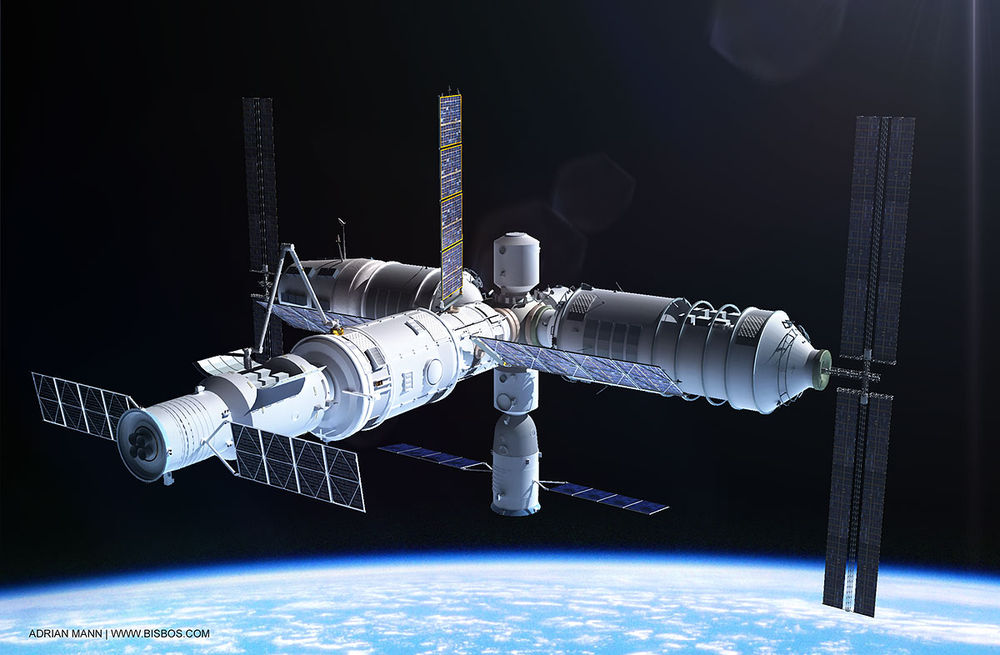China has published a scheme of the space station "Tyangun-3"
The China National Space Administration has published plans for the future Tyangun-3 space station, which it plans to launch in 2018-2022.

The main module of the Tyangun-3 space station is called "Tianhe-1", which means "Galaxy-1". It will include a laboratory and modular sections for storing scientific equipment, a robotic manipulator, and five connecting ports. This module has a mass of 24 tons, its length - 18.1 meters, diameter - 4.1 meters. The module is planned to be put into orbit in 2018 using the “Great March-5” rocket; it will be a hub for future modules and for replenishing the reserves sent to the station from Earth.
Externally, Tianhe-1 resembles the Star module or the Mira base unit, which in turn are based on the Salyut stations. Therefore, the configuration of the modules may resemble the “Mir”, the first multi-module space station.
')

Scheme of the main module "Tianhe-1"
The Tyangun-3 space station will have two scientific modules: Wengtian and Mengtian. In these modules will conduct research in microgravity. Both modules will be 14.4 meters long and 4.1 meters in diameter - as the main module.
Wengtian will be equipped with modular internal racks with its own robotic arm to assist the team in experiments outside the station. The “Mengtian” module will have an additional port for docking with other modules and ships for logistics and repair, as well as for the exit of Taikonaut into open space.
"Wengtian" and "Mengtian" will be put into orbit and docked with the main module in 2020-2022.

Scheme of the scientific module "Wengtain"

Scheme of the scientific module "Mengtain"
Manned ships of the "Shenzhou" series and cargo ships "Tianzhou" will fly to the Tiangong-3 station. Multi-module space station will operate for 10 years. It will help service the future Xuntian space telescope with a 2-meter mirror and a field of view 300 times larger than NASA 's Hubble .
The first Chinese space laboratory "Tyangun-1" was launched in 2011. In June 2012, three taykonavta arrived at the station on a manned ship "Shenzhou-9". The astronauts taught physics to Chinese students right from the on-board laboratory. Now this station from one module is not used. This year, China plans to launch Tiangun-2, the module will accept one team of cosmonauts. Both of these stations are stages of the same space program, the result of which will be the Chinese space station in 2022.

The main module of the Tyangun-3 space station is called "Tianhe-1", which means "Galaxy-1". It will include a laboratory and modular sections for storing scientific equipment, a robotic manipulator, and five connecting ports. This module has a mass of 24 tons, its length - 18.1 meters, diameter - 4.1 meters. The module is planned to be put into orbit in 2018 using the “Great March-5” rocket; it will be a hub for future modules and for replenishing the reserves sent to the station from Earth.
Externally, Tianhe-1 resembles the Star module or the Mira base unit, which in turn are based on the Salyut stations. Therefore, the configuration of the modules may resemble the “Mir”, the first multi-module space station.
')

Scheme of the main module "Tianhe-1"
The Tyangun-3 space station will have two scientific modules: Wengtian and Mengtian. In these modules will conduct research in microgravity. Both modules will be 14.4 meters long and 4.1 meters in diameter - as the main module.
Wengtian will be equipped with modular internal racks with its own robotic arm to assist the team in experiments outside the station. The “Mengtian” module will have an additional port for docking with other modules and ships for logistics and repair, as well as for the exit of Taikonaut into open space.
"Wengtian" and "Mengtian" will be put into orbit and docked with the main module in 2020-2022.

Scheme of the scientific module "Wengtain"

Scheme of the scientific module "Mengtain"
Manned ships of the "Shenzhou" series and cargo ships "Tianzhou" will fly to the Tiangong-3 station. Multi-module space station will operate for 10 years. It will help service the future Xuntian space telescope with a 2-meter mirror and a field of view 300 times larger than NASA 's Hubble .
The first Chinese space laboratory "Tyangun-1" was launched in 2011. In June 2012, three taykonavta arrived at the station on a manned ship "Shenzhou-9". The astronauts taught physics to Chinese students right from the on-board laboratory. Now this station from one module is not used. This year, China plans to launch Tiangun-2, the module will accept one team of cosmonauts. Both of these stations are stages of the same space program, the result of which will be the Chinese space station in 2022.
Source: https://habr.com/ru/post/394483/
All Articles